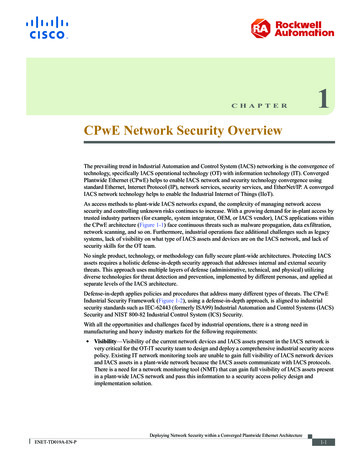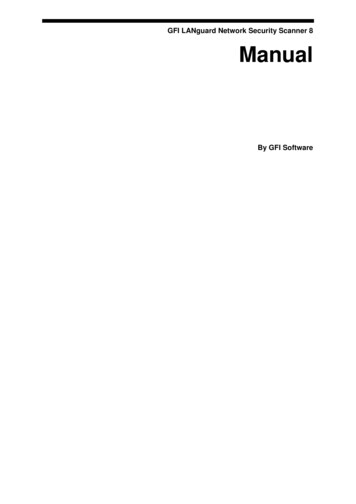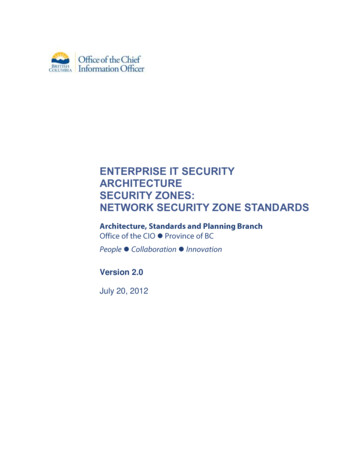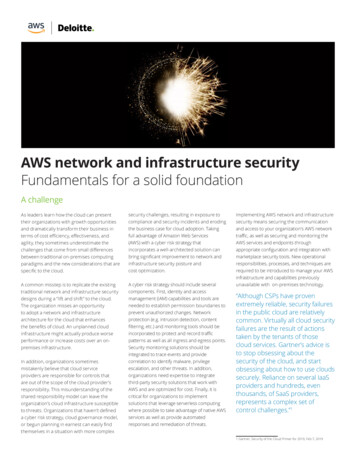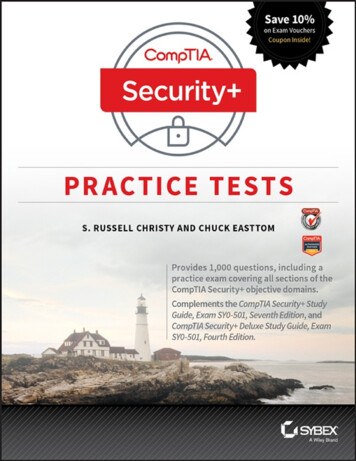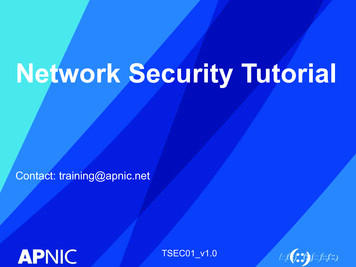
Transcription
Network Security TutorialContact: training@apnic.netTSEC01 v1.0
Overview Network Security Fundamentals Security on Different Layers and Attack Mitigation Cryptography and PKI Resource Registration (Whois Database) Virtual Private Networks and IPsec
Network SecurityFundamentalsNetwork Security Workshop
Overview Why We Need Security Definitions and Concepts Access Control Risk vs. Vulnerability Threats and Attack Types
Why Security? The Internet was initially designed for connectivity– Trust assumed– We do more with the Internet nowadays– Security protocols are added on top of the TCP/IP Fundamental aspects of information must be protected––––Confidential dataEmployee informationBusiness modelsProtect identity and resources We can’t keep ourselves isolated from the Internet– Most business communications are done online– We provide online services– We get services from third-party organizations online
Internet EvolutionLAN connectivityApplication-specificMore online contentCloud computingApplication/data hostedin the cloud environment Different ways to handle security as the Internet evolves
Why Security? Key findings:––––Hacktivism and vandalism are the common DDoS attack motivationHigh-bandwidth DDoS attacks are the ‘new normal’First-ever IPv6 DDoS attacks are reportedTrust issues across geographic boundariesSource: Arbor Networks Worldwide InfrastructureSecurity Report Volume VII
Breach SourcesAggregationInfiltrationExfiltrationSource: Trustwave 2012 Global Security Report
Types of Security Computer Security– generic name for the collection of tools designed to protect data andto thwart hackers Network Security– measures to protect data during their transmission Internet Security– measures to protect data during their transmission over a collectionof interconnected networks
ConfidentialityIntegritypreventsunauthorizeduse ordisclosure ofinformationsafeguards theaccuracy andcompletenessof informationAvailabilityauthorizedusers havereliable andtimely accessto informationSECURITYGoals of Information Security
Access Control The ability to permit or deny the use of an object by asubject. It provides 3 essential services:– Authentication (who can login)– Authorization (what authorized users can do)– Accountability (identifies what a user did)
Authentication A means to verify or prove a user’s identity The term “user” may refer to:– Person– Application or process– Machine or device Identification comes before authentication– Provide username to establish user’s identity To prove identity, a user must present either of the following:– What you know (passwords, passphrase, PIN)– What you have (token, smart cards, passcodes, RFID)– Who you are (biometrics such as fingerprints and iris scan, signature orvoice)
Examples of TokensRFID cardseTokenSmart CardsFingerprint scanner
Trusted Network Standard defensive-oriented technologies– Firewall– Intrusion Detection Build TRUST on top of the TCP/IP infrastructure– Strong authentication– Public Key Infrastructure (PKI)
Strong Authentication An absolute requirement Two-factor authentication– Passwords (something you know)– Tokens (something you have) tsRestricted accessPINsBiometricsCertificates
Two-factor Authentication Requires a user to provide at least two authentication‘factors’ to prove his identity– something you knowUsername/userID and password– something you haveToken using a one-time password (OTP) The OTP is generated using a small electronic device inphysical possession of the user– Different OTP generated each time and expires after some time– An alternative way is through applications installed on your mobiledevice Multi-factor authentication is also common
Authorization Defines the user’s rights and permissions on a system Typically done after user has been authenticated Grants a user access to a particular resource and whatactions he is permitted to perform on that resource Access criteria based on the level of ction type
Authentication vs. zationMechanismClient“Authentication simply identifies a party, authorization defines whether they canperform certain action” – RFC 3552
Authorization Concepts Authorization creep– When users may possess unnecessarily high access privileges withinan organization Default to Zero– Start with zero access and build on top of that Need to Know Principle– Least privilege; give access only to information that the userabsolutely need Access Control Lists– List of users allowed to perform particular access to an object (read,write, execute, modify)
Single Sign On Property of access control where a user logs in only onceand gains access to all authorized resources within asystem. Benefits:– Ease of use– Reduces logon cycle (time spent re-entering passwords for the sameidentity) Common SSO technologies:– Kerberos, RADIUS– Smart card based– OTP Token Disadvantage: Single point of attack
Types of Access Control Centralized Access Control– Radius– TACACS – Diameter Decentralized Access Control– Control of access by people who are closer to the resources– No method for consistent control
Accountability The security goal that generates the requirement for actionsof an entity to be traced uniquely to that entity– Senders cannot deny sending information– Receivers cannot deny receiving it– Users cannot deny performing a certain action Supports nonrepudiation, deterrence, fault isolation,intrusion detection and prevention and after-action recoveryand legal actionSource: NIST Risk Management Guide forInformation Technology Systems
Integrity Security goal that generates the requirement for protectionagainst either intentional or accidental attempts to violatedata integrity Data integrity– The property that data has when it has not been altered in anunauthorized manner System integrity– The quality that a system has when it performs its intended functionin an unimpaired manner, free from unauthorized manipulationSource: NIST Risk Management Guide forInformation Technology Systems
Risk, Threat and Vulnerability Vulnerability - weakness in a system Risk - likelihood that a particular threat using a particularattack will exploit a particular vulnerability Exploit - taking advantage of a vulnerability Non-repudiation—assurance that both parties are involvedin the transaction
Vulnerability A weakness in security procedures, network design, orimplementation that can be exploited to violate a corporatesecurity policy––––Software bugsConfiguration mistakesNetwork design flawLack of encryption Exploit– Taking advantage of a vulnerability
Threat Any circumstance or event with the potential to cause harmto a networked system. These are some example of threats:– Denial of service Attacks make computer resources (e.g., bandwidth, disk space, or CPU time)unavailable to its intended users– Unauthorised access Access without permission issues by a rightful owner of devices or networks– Impersonation– Worms– Viruses
Risk The possibility that a particular vulnerability will be exploited IT-related risks arise from:– Unauthorized (malicious or accidental) disclosure, modification, ordestruction of information– Unintentional errors or omissions– IT disruptions due to natural or man-made disasters– Failure to exercise due care and diligence in implementation andoperation of the IT systemRisk Threat * Vulnerability(* Impact)
Risk Analysis Identification, assessment and reduction of risks to anacceptable level the process of identifying security risks and probability ofoccurrence, determining their impact, and identifying areasthat require protection Three parts:– Risk assessment – determine the possible risks– Risk management – evaluating alternatives for mitigating the risk– Risk communication – presenting this material in an understanbleway to decision makers and/or the public
Risk Management vs. Cost of Security Risk mitigation– The process of selecting appropriate controls to reduce risk to anacceptable level The level of acceptable risk– Determined by comparing the risk of security hole exposure to thecost of implementing and enforcing the security policy Trade-offs between safety, cost, and availability
Attack Sources Active vs. passive– Active involves writing data to the network. It is common to disguiseone’s address and conceal the identity of the traffic sender– Passive involves only reading data on the network. Its purpose is breachof confidentiality. This is possible if: Attacker has gained control of a host in the communication path between two victimmachinesAttacker has compromised the routing infrastructure to arrange the traffic pass through acompromised machineActive AttacksDenial of Service attacksSpoofingMan in the MiddleARP poisoningSmurf attacksBuffer overflowSQL InjectionPassive AttacksReconnaissanceEavesdroppingPort scanningSource: RFC 4778
Attack Sources On-path vs. Off-path– On-path routers (transmitting datagrams) can read, modify, or removeany datagram transmitted along the path– Off-path hosts can transmit datagrams that appear to come from anyhosts but cannot necessarily receive datagrams intended for otherhosts If attackers want to receive data, they have to put themselves on-path– How easy is it to subvert network topology? It is not easy thing to do but, it is not impossible Insider vs. outsider– What is definition of perimeter/border? Deliberate attack vs. unintentional event– Configuration errors and software bugs are as harmful as adeliberate malicious network attackSource: RFC 4778
General Threats Masquerade– An entity claims to be another entity Eavesdropping– An entity reads information it is not intended to read Authorization violation– An entity uses a service or resource it is not intended to use Loss or modification of information– Data is being altered or destroyed Denial of communication acts (repudiation)– An entity falsely denies its participation in a communication act Forgery of information– An entity creates new information in the name of another entity Sabotage– Any action that aims to reduce the availability and/or correct functioning of services orsystems
Reconnaissance Attack Unauthorised users to gather information about the networkor system before launching other more serious types ofattacks Also called eavesdropping Information gained from this attack is used in subsequentattacks (DoS or DDoS type) Examples of relevant information:– Names, email address Common practice to use a person’s first initial and last name for accounts– Practically anything
Man-in-the-Middle Attack Active eavesdropping Attacker makes independent connections with victims andrelays messages between them, making them believe thatthey are talking directly to each other overa privateconnection, when in fact the entire conversation iscontrolled by the attacker Usually a result of lack of end-to-end authentication Masquerading - an entity claims to be another entity
Session Hijacking Exploitation of a valid computer session, to gainunauthorized access to information or services in acomputer system. Theft of a “magic cookie” used to authenticate a user to aremote server (for web developers) Four methods:– Session fixation – attacker sets a user’s session id to one known tohim, for example by sending the user an email with a link thatcontains a particular session id.– Session sidejacking – attacker uses packet sniffing to read networktraffic between two parties to steal the session cookie.
Denial of Service (DoS) Attack Attempt to make a machine or network resource unavailable toits intended users. Purpose is to temporarily or indefinitely interrupt or suspendservices of a host connected to the Internet Methods to carry out this attack may vary– Saturating the target with external communications requests (such that itcan’t respond to legitimate traffic) – SERVER OVERLOAD– May include malware to max out target resources (such as CPU), triggererrors, or crash the operating system DDoS attacks are more dynamic and comes from a broaderrange of attackers Examples: SYN flooding, Smurf attacks, Starvation Can be used as a redirection and reconnaissance technique
Questions?
Layered Security &Attack MitigationNetwork Security Workshop
Overview Attacks in Different Layers Security Technologies Link-Layer Security Network Layer Security Transport Layer Security Application Layer Security
Attacks on Different rkData LinkPhysicalOSI Reference ModelLayer 7: DNS, DHCP, HTTP, FTP, IMAP,ApplicationLDAP, NTP, Radius, SSH, SMTP, SNMP,Telnet, TFTPDNS Poisoning, Phishing,SQL injection, Spam/ScamLayer 5: SMB, NFS, SocksTransportLayer 4: TCP, UDPTCP attacks, Routingattack, SYN flooding,SniffingInternetLayer 3: IPv4, IPv6, ICMP,IPSecPing/ICMP FloodLayer 2: PPTP, Token RingARP spoofing, MACNetwork AccessfloodingTCP/IP Model
Layer 2 Attacks ARP Spoofing MAC attacks DHCP attacks VLAN hopping
1 SpoofingARPI want to connect to10.0.0.3. I don’t know theMAC addressWait, I am 10.0.0.3!10.0.0.2BB-BB-BB-BB-BB-BBARP Request10.0.0.1AA-AA-AA-AA-AA-AAClient’s ARP Cache already poisonedIt will communicate directly to the fakedestinationARP DDDDI am 10.0.0.3. This ismy MAC address
MAC Flooding Exploits the limitation of all switches – fixed CAM table size CAM Content Addressable memory stores info on themapping of individual MAC addresses to physical ports onthe switch.Port C300:01:23:45:67:D4Port2Port3Port4xxxx
DHCP Attacks DHCP Starvation Attack– Broadcasting vast number of DHCP requests with spoofed MACaddress simultaneously.– DoS attack using DHCP leases Rogue DHCP Server AttacksServer runs out of IP addressesto allocate to valid usersAttacker sends many different DHCP requestswith many spoofed addresses.
DHCP Attack Types Solution: enable DHCP snoopingip dhcpip dhcpvlans)ip dhcpip dhcpsnooping (enable dhcp snooping globally)snooping vlan vlan-id (for specificsnooping trustsnooping limit rate rate
Layer 3 Attacks ICMP Ping Flood ICMP Smurf Ping of death
1 FloodPingInternetAttackerOther forms of ICMP attack:-Ping of death-ICMP ping floodVictimBroadcast EnabledNetwork
Mitigating Sniffing Attacks Avoid using insecure protocols like basic HTTPauthentication and telnet. If you have to use an insecure protocol, try tunneling itthrough something to encrypt the sensitive data. Run ARPwatch. Try running tools like sniffdet and Sentinel to detect networkcards in promiscuous mode that may be running sniffingsoftware.
Routing Attacks Attempt to poison the routing information Distance Vector Routing– Announce 0 distance to all other nodes Blackhole traffic Eavesdrop Link State Routing– Can drop links randomly– Can claim direct link to any other routers– A bit harder to attack than DV BGP attacks– ASes can announce arbitrary prefix– ASes can alter path
TCP Attacks SYN Flood – occurs when an attacker sends SYN requestsin succession to a target. Causes a host to retain enough state for bogus halfconnections such that there are no resources left toestablish new legitimate connections.
TCP Attacks Exploits the TCP 3-way handshake Attacker sends a series of SYN packets without replyingwith the ACK packet Finite queue size for incomplete connectionsSYNSYN ACKAttackerServer(Victim)ACK?OPEN CONNECTIONS
1ApplicationLayer Attacks Applications don’t authenticate properly Authentication information in clear– FTP, Telnet, POP DNS insecurity– DNS poisoning– DNS zone transfer
1ApplicationLayer Attacks Scripting vulnerabilities Cookie poisoning Buffer overflow Hidden field manipulation Parameter tampering Cross-site scripting SQL injection
Application-Layer AttacksSource: Arbor Networks Worldwide InfrastructureSecurity Report Volume VII
Application Layer DDoS: Slowloris Incomplete HTTP requests Properties–––––Low bandwidthKeep sockets aliveOnly affects certain web serversDoesn’t work through load balancersManaged to work around accf http
Web Application Security Risks Injection Cross-Site Scripting Broken authentication and Session Management Insecure Direct Object References Cross-site Request Forgery (CSRF) Insecure Cryptographic Storage Failure to Restrict URL Access Insufficient Transport Layer Protection Unvalidated Redirects and ForwardsSource: OWASP Top 10 Application Security Risks, 2010
DNS Changer “Criminals have learned that if they can control a user’sDNS servers, they can control what sites the user connectsto the Internet.” How: infect computers with a malicious software (malware) This malware changes the user’s DNS settings with that ofthe attacker’s DNS servers Points the DNS configuration to DNS resolvers in specificaddress blocks and use it for their criminal enterprise For more: see the NANOG presentation by Merike
Rogue DNS Servers 85.225.112.0 through 85.255.127.255 67.210.0.0 through 67.210.15.255 93.188.160.0 through 93.188.167.255 77.67.83.0 through 77.67.83.255 213.109.64.0 through 213.109.79.255 64.28.176.0 through 64.28.191.255 If your computer is configured with one of these DNSservers, it is most likely infected with DNSChanger malware
Top DNS Changer Infections By country (as of 11 June, 2012):–––––USA - 69517IT – 26494IN – 21302GB – 19589DE – 18427 By ASNs–––––AS9829 (India) – 15568AS3269 () – 13406AS7922 () – 11964AS3320 () – 9250AS7132 () – 6743 More info at http://dcwg.org/
DNS VulnerabilitiesCorrupting data"Zone administratorZone fileImpersonating master"1"Cache impersonation"4"masterCaching forwarder2"3"Dynamicupdates5"slavesUnauthorized updates"Server protection!Cache pollution by"Data spoofing"resolverData protection!
DNS Cache Poisoning Caching incorrect resource record that did not originatefrom authoritative DNS sources. Result: connection (web, email, network) is redirected toanother target (controlled by the attacker)
DNS Cache Poisoning31www.example.com 192.168.1.99I want to accesswww.example.comQID 64569QID 64570QID 64571 match!(pretending to bethe authoritativezone)2ClientDNS CachingServerQID 64571Root/GTLDQID 645713www.example.com 192.168.1.1Webserver(192.168.1.1)ns.example.com
DNS AmplificationRoot/GTLDQueries forwww.example.comDNS Recursive serverns.example.comwww.example.com 192.168.1.1CompromisedMachines(spoofed IP)Victim ServerAttacker
Common Types of Attack Ping sweeps and port scans - reconnaissance Sniffing – capture packet as they travel through the network Man-in-the-middle attack – intercepts messages that areintended for a valid device Spoofing - sets up a fake device and trick others to sendmessages to it Hijacking – take control of a session Denial of Service (DoS) and Distributed DoS (DDoS)
Wireless Attacks WEP – first security mechanism for 802.11 wirelessnetworks Weaknesses in this protocol were discovered by Fluhrer,Mantin and Shamir, whose attacks became known as “FMSattacks” Tools were developed to automate WEP cracking Chopping attack were released to crack WEP moreeffectively and faster Cloud-based WPA cracker– https://www.wpacracker.com/
Man in the Middle Attacks (Wireless) Creates a fake access point and have clients authenticateto it instead of a legitimate one. Capture traffic to see usernames, passwords, etc that aresent in clear text.
Botnet Collection of compromised computers (or ‘bot’) Computers are targeted by malware (malicious software) Once controlled, an attacker can use the compromisedcomputer via standards-based network protocol such asIRC and HTTP How to become a bot:– Drive-by downloads (malware)– Go to malicious websites (exploits web browser vulnerabilities)– Run malicious programs (Trojan) from websites or as emailattachment
Password Cracking Dictionary attacks– Guessing passwords using a file of 1M possible password values Ordinary words and people’s names– Offline dictionary attack when the entire password file has beenattacked– Use random characters as password with varying upper and lowercase, numbers, and symbols Brute-force attacks– Checking all possible values until it has been found– The resource needed to perform this attack grows exponentially whileincreasing the key size Social engineering
Pharming and Phishing Phishing – victims are redirected to a fake website thatlooks genuine. When the victim supplies his account andpassword, this can be used by the attacker to the target site– Typically uses fraud emails with clickable links to fake websites Pharming – redirect a website’s traffic to another fake siteby changing the victim’s DNS settings or hosts file
Security on Different rkData LinkPhysicalLayer 7: DNS, DHCP, HTTP, FTP,IMAP, LDAP, NTP, Radius, SSH,SMTP, SNMP, Telnet, TFTPDNSHTTPS,Poisoning,DNSSEC,Phishing,PGP, SQLSMIMEinjection, Spam/ScamLayer 5: SMB, NFS, SocksTCP attacks,attack,TLS, RoutingSSL, SSHSYN flooding, SniffingLayer 4: TCP, UDPLayer 3: IPv4, IPv6, ICMP, IPSecPing/ICMPFloodIPSecLayer 2: ARP, Token RingIEEE spoofing,ARP802.1X, PPPMAC&floodingPPTP
Link-Layer Security Layer 2 Forwarding (L2F) Point-to-Point Tunneling Protocol (PPTP) Layer 2 Tunneling Protocol (L2TP)
Layer 2 Forwarding Protocol Created by Cisco Systems and replaced by L2TP Permits the tunneling of the link layer – High-level Data LinkControl (HDLC), async HDLC, or Serial Line InternetProtocol (SLIP) frames – of higher-level colPPP (Data)PassengerProtocol
Point to Point Tunneling Protocol Initiated by Microsoft but later became an informationalstandard in the IETF (RFC 2637) Client/server architecture that allows PPP to be tunneledthrough an IP network and decouples functions that exist incurrent NAS. Connection-oriented
Layer 2 Tunneling Protocol Combination of L2F and PPTP Published as RFC 2661 and known as L2TPv2 L2TPv3 provides additional security features and the abilityto carry data links other than PPP The two end-points are L2TP Access Concentrator (LAC) orL2TP Network Server (LNS)
PPPoE PPP over Ethernet Defined in RFC 2516 A means to encapsulate PPP packets over the Ethernet linklayer Mostly used in ADSL environments to provide accesscontrol, billing, and type of service on a per-user rather thana per-site basis
Transport Layer Security Secure Socket Layer (SSL) Secure Shell Protocol SOCKS Protocol
SSL/TLS TLS and SSL encrypts the segments of networkconnections above the Transport Layer. Versions:– SSLv1 – designed by Netscape– SSLv2 – publicly released in 1994; has a number of security flaws;uses RC4 for encryption and MD5 for authentication– SSLv3 – added support for DSS for authentication and DH for keyagreement– TLS – based on SSLv3; uses DSS for authentication, DH for keyagreement, and 3DES for encryption TLS is the IETF standard which succeeded SSL.
SSL HandshakeSSL ClientSSL ServerClient initiates SSL connectionServer sends digital certificateand selected cipher suiteClient sends encrypted shared secretMessage encryption and integrity algorithmsare negotiatedSession keys are generated
Advantages of SSL The connection is private– Encryption is used after initial handshake to define a secret key– Encryption uses symmetric cryptography (DES or RC4) Peer’s identity can be authenticated using asmmetriccryptography (RSA or DSS) The connection is reliable– Message transport includes message integrity check using a keyedMAC. Secure hash functions (SHA or MD5) are used for MACcomputation.
Applications Using SSL/TLSProtocolDefined Port NumberSSL/TLS Port 5995
Secure Shell Protocol (SSH) Protocol for secure remote login Provides support for secure remote login, secure filetransfer, and secure forwarding of TCP/IP and X WindowSystem traffic Consists of 3 major components:– Transport layer protocol (server authentication, confidentiality,integrity)– User authentication protocol (authenticates client to the server)– Connection protocol (multiplexes the encrypted tunnel into severallogical channels)
Application Layer Security HTTPS PGP (Pretty Good Privacy) SMIME (Secure Multipurpose Internet Mail Extensions) TSIG and DNSSEC Wireless Encryption - WEP, WPA, WPA2
HTTPS Hypertext Transfer Protocol Secure Widely-used, message-oriented communications protocol Connectionless oriented protocol Technically not a protocol in itself, but simply layering HTTPon top of the SSL/TLS protocol Encapsulates data after security properties of the session Not to be confused with S-HTTPNote: A website must use HTTPS everywhere, otherwise it is stillvulnerable to some attacks
Pretty Good Privacy (PGP) Stands for Pretty Good Privacy, developed by PhilZimmerman in 1995 PGP is a hybrid cryptosystem– combines some of the best features of both conventional and publickey cryptography Assumptions:– All users are using public key cryptography and have generatedprivate/public key pairs (using RSA or El Gamal)– All users also use symmetric key system (DES or Rijndael) Offers authentication, confidentiality, compression, e-mailcompatibility and segmentation
S/MIME Secure Multipurpose Internet Mail Extensions Uses public key certificates conforming to standard X.509 Very similar to PGP
Securing the Nameserver Run the most recent version of the DNS software– Bind 9.9.1 or Unbound 1.4.16– Apply the latest patches Hide version Restrict queries– Allow-query { acl match list; }; Prevent unauthorized zone transfers– Allow-transfer { acl match list; }; Run BIND with the least privilege (use chroot) Randomize source ports– don’t use query-source option Secure the box Use TSIG and DNSSEC
DNSSEC DNSSEC – Domain Name Security Extensions A set of extensions to DNS that provides– Origin authentication of DNS data– Data integrity– Authenticated denial of existence designed to protect against attacks such as DNS cachepoisoning. Adds four new resource record types:––––RRSIG (Resource Record Signature)DNSKEY (DNS Public Key)DS (Delegation Signer)NSEC (Next Secure)
Questions?
CryptographyNetwork Security Workshop
Overview What is Cryptography? Symmetric Key Cryptography Asymmetric Key Cryptography Block and Stream Cipher Digital Signature and Message Digest
Cryptography Cryptography is everywhereGerman Lorenz cipher machine
Cryptography Cryptography deals with creating documents that can beshared secretly over public communication channels Other terms closely associated– Cryptanalysis code breaking– Cryptology Kryptos (hidden or secret) and Logos (description) secret speech / communication combination of cryptography and cryptanalysis Cryptography is a function of plaintext and a cryptographickeyC F(P, k)Notation:Plaintext (P)Ciphertext (C)Cryptographic Key (k)
Typical Scenario Alice wants to send a “secret” message to Bob What are the possible problems?– Data can be intercepted What are the ways to intercept this message? How to conceal the message?– Encryption
Crypto Core Secure key establishmentAlice has key (k)Bob has key (k) Secure communicationmmmConfidentiality and integrityAlice has key (k)Bob has key (k)Source: Dan Boneh, Stanford
It can do much more Digital Signatures Anonymous communication Anonymous digital cash– Spending a digital coin without anyone knowing my identity– Buy online anonymously? Elections and private auctions– Finding the winner without actually knowing individual votes (privacy)Source: Dan Boneh, Stanford
Other uses are also theoreticallypossible (Crypto magic)What didshe searchfor? Privately outsourcing computationE(query)E(results)Alice withsearch queryGoogle Zero knowledge (proof of knowledge)I know the factorial of NProofI know the factorial of NBobSource: Dan Boneh, Stanford
History: Ciphers Substitution cipher– involves replacing an alphabet with another character of the samealphabet set– Can be mono-alphabetic (single set for substitution) or polyalphabetic system (multiple alphabetic sets) Example:– Caesar cipher, a mono-alphabetic system in which each character isreplaced by the third character in succession– Vigenere cipher, a poly-alphabetic cipher that uses a 26x26 table ofcharacters
How to Break a Substitution PUKBZPUNVR(1) Use frequency of the English letterse 12.7%t 9.1 %a 8.1%(2) Use frequency of pairs of lettershe, in, an, thIn the example,B appeared 36 times, U 33 times, and P 32 timesNC appeared 11 times, PU 10 timesUKB appeared 6 timesSource: Dan Boneh, Stanford
Transposition Cipher No letters are replaced, they are just rearranged. Rail Fence Cipher – another kind of transposition cipher inwhich the words are spelled out as if they were a rail fence.
History: Rotor Machines (1870-1943) Hebern machine – single rotor Enigma - 3-5 rotors
Modern Crypto Algorithms specifies the mathematical transformation that is performedon data to encrypt/decrypt Crypto algorithm is NOT proprietary Analyzed by public community to show that there are noserious wea
Why Security? The Internet was initially designed for connectivity – Trust assumed – We do more with the Internet nowadays – Security protocols are added on top of the TCP/IP Fundamental aspects of information must be protected – Confidential data
